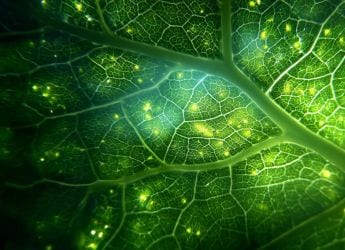- Home
- Science
- Science News
- Scientists Solve Decades Old Photosynthesis Puzzle With IISc–Caltech Study
Scientists Solve Decades-Old Photosynthesis Puzzle With IISc–Caltech Study
IISc and Caltech researchers uncover why photosynthesis uses only one electron path, solving a long-standing mystery.

Photo Credit: Wikipedia Common
IISc and Caltech researchers reveal why photosynthesis favors one electron pathway over another
A decades-old question, the first steps of photosynthesis, has been addressed by scientists from the Indian Institute of Science (IISc) and the California Institute of Technology (Caltech). By the process, plants, algae, and bacteria turn sunlight into energy. In the studies of the reactions within Photosystem II (PSII), scientists trace out why electrons adhere to only one of two identical pathways. These findings open the door to how subtle molecular differences decide the direction of electron flow. This also provides a new glimpse that helps the design of artificial photosynthetic systems.
Scientists Discover Why Only One Pathway Powers Electron Flow in Photosynthesis
According to a joint IISc-Caltech study, electrons in PSII should theoretically move along both D1 and D2 branches. However, the study denoted that the D2 branch has a much higher energy barrier, making electron transfer nearly impossible. The researchers mapped the energy patterns by using molecular dynamics simulations and quantum mechanical models. They found that the D1 branch allows smoother and faster electron flow due to lower activation energy.
Moreover, the team identified that the surrounding protein environment and pigment placement favour the D1 branch. The resistance to electron movement in D2 was seen to be around 100 times higher. This states why only the D1 side works in natural photosynthesis.
It may be possible to rewire this process by tweaking pigment arrangements or swapping certain molecules suggested by researchers. It helps to create artificial photosynthesis systems for clean energy. This is a breakthrough in bioenergy research, facilitating a comprehension of how nature captures sunlight so efficiently.
These insights could help to design next-generation solar-based fuel systems revealed by Professor Prabal K. Maiti from IISc. Caltech's Bill Goddard noted that while many mysteries remain, the research marks a major theoretical and experimental advance in understanding life's most essential energy process.
For the latest tech news and reviews, follow Gadgets 360 on X, Facebook, WhatsApp, Threads and Google News. For the latest videos on gadgets and tech, subscribe to our YouTube channel. If you want to know everything about top influencers, follow our in-house Who'sThat360 on Instagram and YouTube.
Related Stories
- Samsung Galaxy Unpacked 2025
- ChatGPT
- Redmi Note 14 Pro+
- iPhone 16
- Apple Vision Pro
- Oneplus 12
- OnePlus Nord CE 3 Lite 5G
- iPhone 13
- Xiaomi 14 Pro
- Oppo Find N3
- Tecno Spark Go (2023)
- Realme V30
- Best Phones Under 25000
- Samsung Galaxy S24 Series
- Cryptocurrency
- iQoo 12
- Samsung Galaxy S24 Ultra
- Giottus
- Samsung Galaxy Z Flip 5
- Apple 'Scary Fast'
- Housefull 5
- GoPro Hero 12 Black Review
- Invincible Season 2
- JioGlass
- HD Ready TV
- Laptop Under 50000
- Smartwatch Under 10000
- Latest Mobile Phones
- Compare Phones
- Honor Magic 8 Pro
- Honor Magic 8
- Moto X70 Air
- Moto G100 (2025)
- Vivo X300 Pro
- Vivo X300
- Samsung W26
- Samsung Galaxy M17 5G
- MacBook Pro 14-inch (M5, 2025)
- Asus Vivobook S16 (S3607QA)
- Apple iPad Pro 13-inch (2025) Wi-Fi + Cellular
- Apple iPad Pro 13-inch (2025) Wi-Fi
- Honor Watch 5 Pro
- Vivo Watch GT 2
- Xiaomi Xiaomi TV S Pro Mini LED 55 2026
- Xiaomi TV S Pro Mini LED 65 2026
- Asus ROG Ally
- Nintendo Switch Lite
- Haier 1.6 Ton 5 Star Inverter Split AC (HSU19G-MZAID5BN-INV)
- Haier 1.6 Ton 5 Star Inverter Split AC (HSU19G-MZAIM5BN-INV)

















